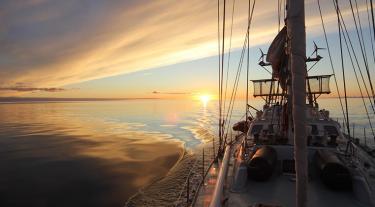The research project, managed by the Carbon Trust confirmed that minke whales showed a clear response to ADDs, demonstrating the effectiveness of this technology on this important species. The results help to increase confidence that when used in conjunction with other mitigation measures ADDs could prevent adverse effects of subsea piling noise.
Previous studies have demonstrated that ADDs effectively deter seals and harbour porpoise, however until now there has been little research into the use of ADDs as a deterrent for minke whale. As minke whale are an important species in UK waters, the ORJIP study was set up to address this knowledge gap. The objective was to increase confidence in ADDs and specifically improve the techniques and understanding of safely deterring marine mammals during offshore wind construction.
During the field research the whales were observed to display a clear and sustained movement away from the ADD deployment site, adopting faster swim speeds with more directed movement. A total of 246 minke whales were sighted, of which 46 focal whales were tracked. Focal follows including successful ADD deployment were carried out on 15 occasions. In all 15 deployments, the focal animal moved away from the ADD deployment site following activation of the unit.
During the construction of wind farms, where percussive pile driving is required for foundation installation, increased underwater noise levels are generated. At close range this could potentially be harmful to a number of marine mammals. The detection of marine mammals is currently carried out by marine mammal observers (MMOs) posted offshore, or passive acoustic monitoring. These methods of detection have limitations as their effectiveness is restricted by sea state, visibility and mammal vocalisation.
The ability to use active acoustic systems to create a temporary safety exclusion zone around the turbine would help to further mitigate any harmful impact, thus increasing confidence that marine mammals are adequately protected when operating in harsh conditions or poor visibility, without the need to unnecessarily delay construction operations.
In a joint statement innogy, Statoil & Ørsted said:
“This valuable research complements the extensive measures already undertaken by the industry to protect marine mammals, including working closely with organisations such as Natural England and the Marine Management Organisation as well as undertaking extensive environmental studies before progressing with construction on individual projects. As the developers involved in this important project have proactively engaged and supported the ORJIP ADD programme in order to ensure all our projects effectively mitigate any potential harmful impacts on these important species. We are pleased to see that these trials have increased the evidence base proving the efficacy of ADDs in deterring marine mammals.”
Olivia Burke, manager of the ORJIP ADD project at the Carbon Trust commented:
“The results from this research are really exciting and are result of many organisations working together to help shed light on this important area. The findings will help increase industry and regulator confidence in the use of ADDs to actively manage the protection of marine mammals during piling phase of construction.”
The study site was located in Faxaflói Bay, southwest Iceland, selected as it is a summer feeding ground for minke whales and therefore ensured a high whale population density. Researchers worked from the specialist cetacean research vessel Song of the Whale and a secondary smaller vessel to ensure minimal disturbance. The Lofitech ADD device was chosen for the research as it had the greatest body of scientific evidence demonstrating efficacy at deterring other marine mammals. Video range tracking (VRT) was also deployed to measure minke whale response to ADDs in field.
Tracking results demonstrated that focal minke whales responded to ADDs at distances which could prevent injurious effects of subsea noise. The study revealed that the selection of appropriate ADD devices for mammals with different hearing frequencies and appropriate deployment periods for the underwater environment were important considerations to ensure successful ADD deployment.
This body of research has improved the current evidence base available on the reaction of marine mammals to ADDs, helping to reduce the knowledge gap and support the use of ADDs as an effective mitigation measure to reduce the potential for injurious effects from piling. This could also reduce the number of personnel deployed to monitor marine mammal presence offshore to minimise health and safety risks as the industry continues to grow.
For further information or images please contact Ainslie MacLeod, Senior PR Manager at the Carbon Trust: E: ainslie.macleod@carbontrust.com or T: +44 (0) 20 7170 7000
About Offshore Renewables Joint Industry Programme (ORJIP)
The Offshore Renewables Joint Industry Programme (ORJIP) is a joint industry project involving the Carbon Trust, Marine Scotland, The Crown Estate, The Crown Estate Scotland and offshore wind developers.
Each project undertaken through ORJIP Offshore Wind is also supported by an advisory expert panel which includes leading experts from Statutory Nature Conservation Bodies, academics and other organisations.


